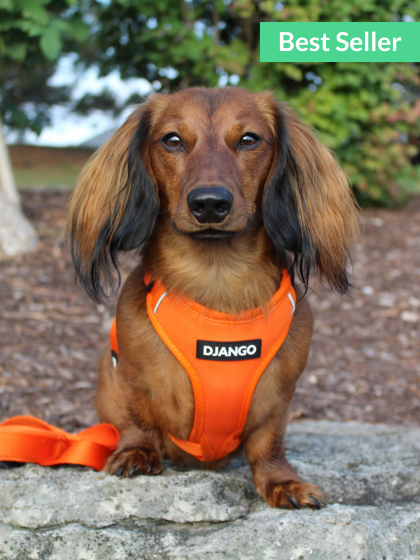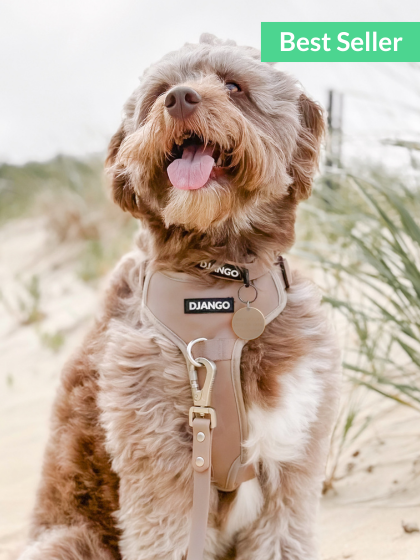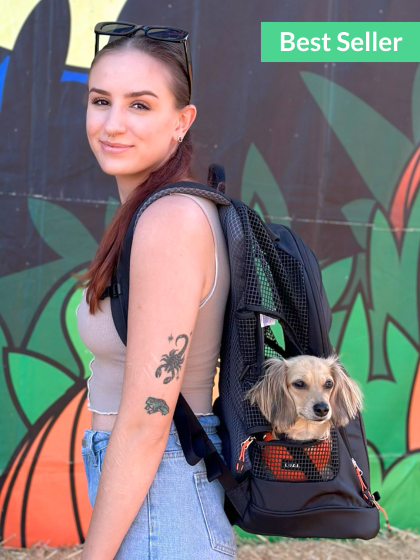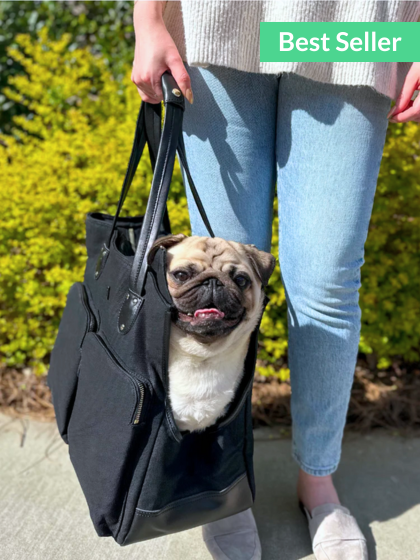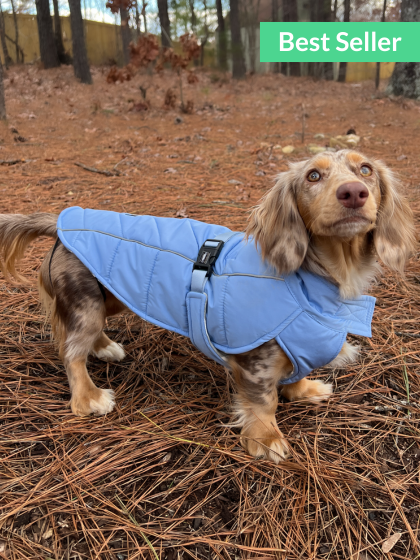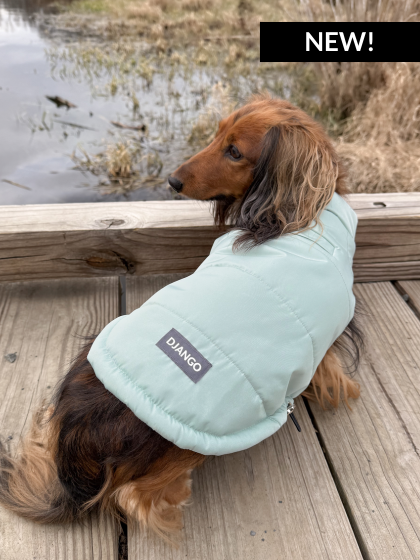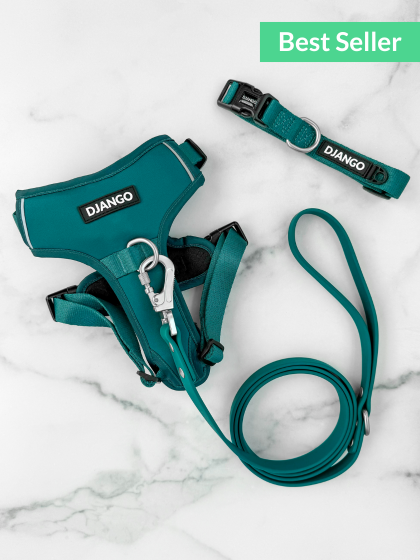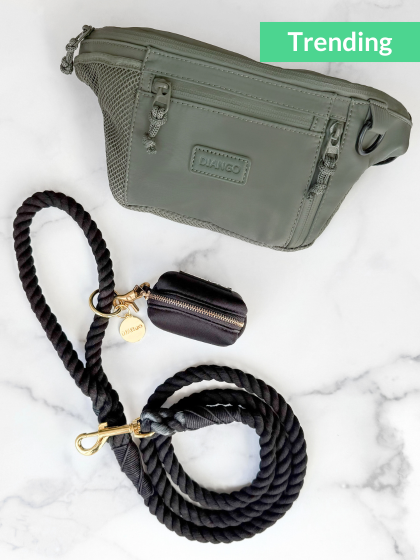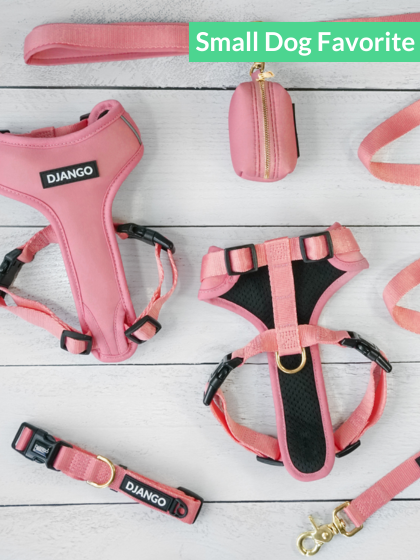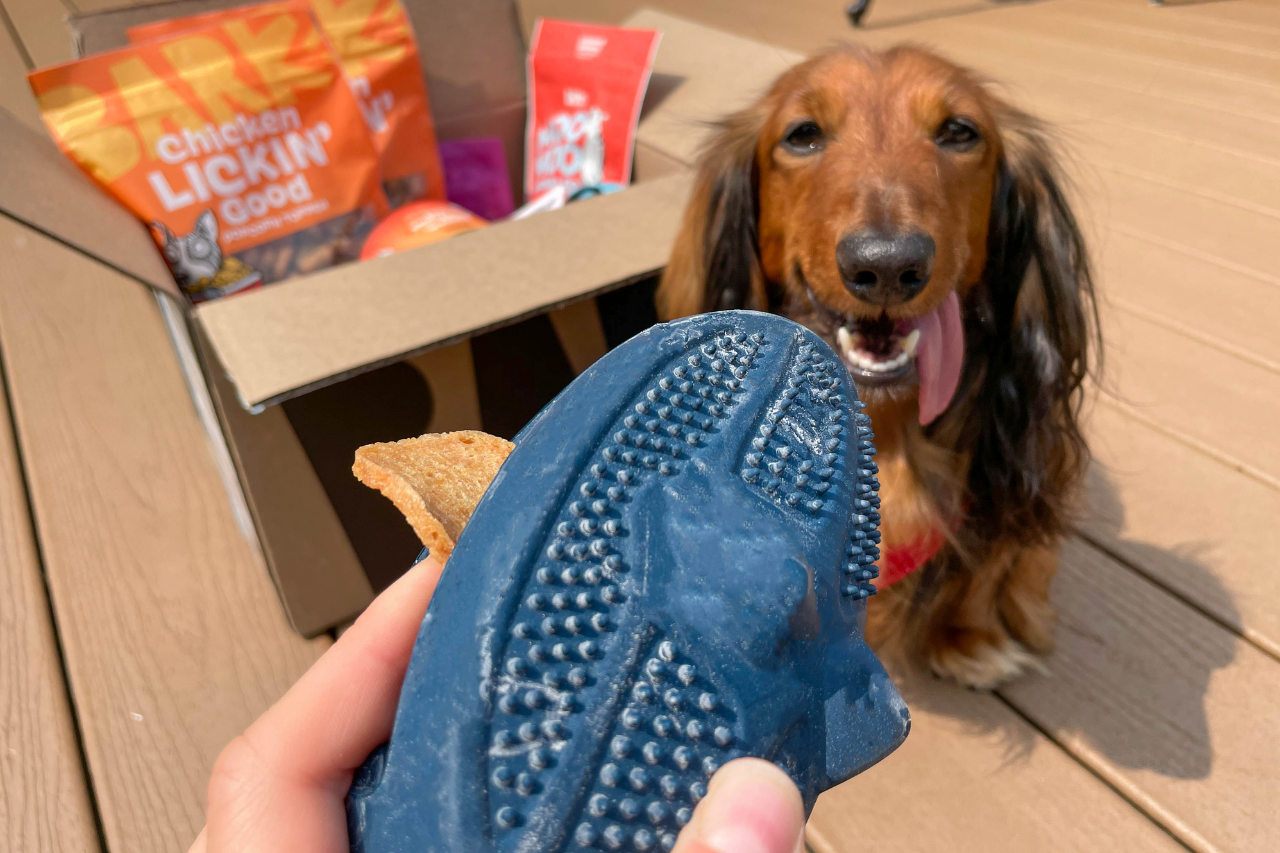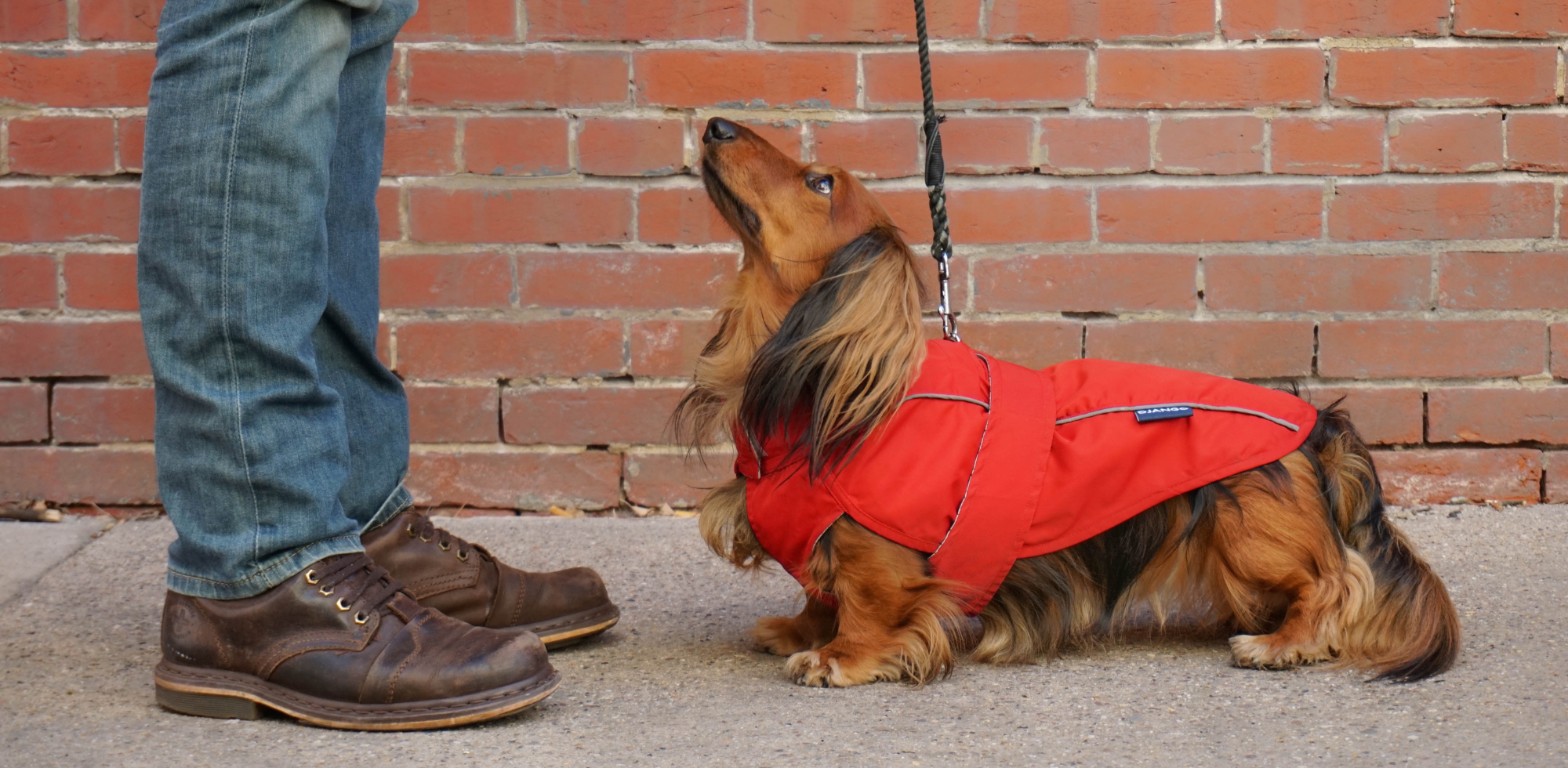Does your small dog pull during walks? If yes, we (Mike and Steph) can relate! We lovingly joke that our 13lb long-haired dachshund, Django, was a sled dog in another life. Despite being leash trained, Django has moments where he loves pulling during outings. He leans forward into his padded dog harness and attempts to run forward despite the pull of the leash behind him.
If this sounds like your dog, it is likely time to consider a front clip dog harness. Front clip dog harnesses, also known as no pull dog harnesses, are one of the best things to use to stop a dog from pulling. Rather than traditional leash attachment on the back of the harness, no pull harnesses feature a front D-ring for leash attachment.
In this DJANGO Dog Blog article, we explore how to choose the best no pull harness for small dogs. We also discuss how front clip dog harnesses work and why leash pulling is potentially dangerous for pups and their humans.
Miniature red dachshund Dexter (@windycity.squad) explores the great outdoors in his DJANGO Tahoe No Pull Dog Harness in color Dark Teal Green.
FINDING THE BEST NO PULL DOG HARNESS FOR SMALL DOG BREEDS
With a proper-fitting, comfortable, and lightweight front clip harness, you can improve your dog's leash skills and gain more control during your walks. Here is what to look for when shopping for a no pull dog harness for your pup.
COMFORT IS KEY
It is important to find a harness that maximizes your dog's comfort at all times. Whether your pup is lounging indoors by a sun-drenched window or exploring a mountain trail during a 5-mile hike, he or she should always be comfortable and safe in the harness you choose.
Two factors will determine comfort: fit and materials. Regarding fit, it is extremely important you select a harness sizing designed for your dog's unique measurements. Review the harness sizing chart before ordering. Your dog's chest girth will always be the most important measurement to get right. Ideally, the harness has an adjustable neck strap, like DJANGO's adjustable Tahoe No Pull Dog Harness. If the harness neck strap is not adjustable, make sure you also take your pup's neck girth measurement before ordering.
Materials—what the harness is made of—are key indicators of comfort and quality. All of DJANGO's popular dog harnesses are made with neoprene, the fabric that wetsuits are made of. Our custom neoprene is tough, water-repellent, and very easy to clean. The interior lining of DJANGO harnesses is breathable sport mesh, and our dual side-release harness buckles are military grade and secure. Even our no pull harness D-rings are made from a beautiful, heavy-duty, and rich-looking silver plated alloy metal.
PADDED AND LIGHTWEIGHT BODY
Look for no pull harnesses that are both padded and lightweight. These qualities are especially important if your dog is a smaller breed.
Padded dog harnesses will provide an extra layer of comfort for your dog during outings and prevent chafing and discomfort during use. Imagine buying a backpack for yourself that is made with very thin, rough, and unlined shoulder straps. Would you want to wear this type of product on your bare shoulders all day? Absolutely not.
If your dog is on the smaller side (< 30 lbs), finding a lightweight harness is also important. There is no need to get a harness that is overly bulky or heavy.
DURABLE AND HIGH QUALITY
It should go without saying, but the harness you buy will ideally last for years and years to come. The harness "should not become easily worn or spontaneously break," says Dr. Paula Simons, a veterinarian with K9 of Mine.
When it comes to dog harnesses, you usually get what you pay for. Yes, you can find harnesses for $19.99 online, but don't expect them to last more than a season. If you want a high quality dog harness that will not only provide comfort for your dog but also last for years, invest in a harness known for its premium materials, construction, and design.
ADDITIONAL CONSIDERATIONS
NO PULL DOG HARNESSES WITH DUAL LEASH ATTACHMENTS ARE BEST
Look for a versatile dual-clip dog harness with front and back leash D-rings for leash attachment. As Dr. Simon explains, "The front clip directly stops pulling by redirecting the movement of the body to the side and preventing forward motion. Back clips should be used once your dog understands pulling is inappropriate. Back clip harnesses can encourage pulling, especially because your dog can pull forward with his body weight."
DJANGO's Tahoe No Pull Dog Harness is a great example of a high quality dual-clip harness that lets you choose which leash attachment to use based on your dog's behavior and needs.
FOR DOGS WITH ARTHRITIS AND JOINT ISSUES
If you have a senior dog with arthritis or a pup with joint issues, it is very important to select a harness that can be put on and removed without lifting your dog's front or hind legs. This is also important if you have a young and healthy dog that is genetically prone to joint issues down the road. Chihuahuas, Boston terriers, Maltese, Jack Russell terriers, and Cavelier King Charles spaniels are more susceptible to patellar luxation, for example. This common condition causes the knee cap (patella) to pop out of its socket.
All DJANGO dog harnesses feature two secure and side-release buckles on the chest strap so you never have to lift up your dog's front legs and put pressure on the canine's joints. After you slide your DJANGO dog harness over your dog's head, gently slide the harness body and chest straps under his chest and behind the front legs. Once the chest straps are positioned behind the front legs, simply clip them into their respective buckles.
Taking off DJANGO dog harnesses is equally easy and pain-free for small dog breeds with joint issues or arthritis. Simply undo the side release buckles on each chest strap, then carefully pull the harness over your pup's head.
WHERE CAN I BUY A DJANGO DOG HARNESS?
Shop DJANGO's no pull dog harness collection on djangobrand.com and amazon.com/django. DJANGO offers free U.S. shipping on djangobrand.com. For those that prefer to order via Amazon, Prime members enjoy free and fast shipping on all DJANGO orders placed on the marketplace.
DJANGO is a USA small business. We design premium, rugged, and weather-resistant dog gear for small and medium-sized adventure pups and their humans. Our mission is to help you and your dog to go outside and travel together more often.
Besides our website and Amazon, you can find DJANGO harnesses at many pet boutiques and pet stores throughout the USA, Canada, the UK, and the EU. Ask your local retail pet stores if they carry DJANGO dog products.
 Jack Russell Terrier Gunnar of @gunnerthejack (left) explores the Black Rock Desert in west-central Utah. He is adventuring in a DJANGO Tahoe No Pull Dog Harness in Poppy Seed Gray, size small. Tato the corgi of @corgitato (right) is wearing her Poppy Seed Gray DJANGO Tahoe No Pull Dog Harness in size medium.
Jack Russell Terrier Gunnar of @gunnerthejack (left) explores the Black Rock Desert in west-central Utah. He is adventuring in a DJANGO Tahoe No Pull Dog Harness in Poppy Seed Gray, size small. Tato the corgi of @corgitato (right) is wearing her Poppy Seed Gray DJANGO Tahoe No Pull Dog Harness in size medium.
HOW DO NO PULL DOG HARNESSES WORK?
No pull dog harnesses have a leash attachment, typically a strong D-ring, located in the front chest area of the harness. Once you attach your dog leash to the front D-ring and start moving with your dog, your dog is forced to walk without pulling in order to move forward.
What happens if your pup continues to pull like a sled dog? The front leash attachment will "turn your dog's body instead of allowing him to move forward in a straight line," says Dr. Simons. Ultimately, front leash attachment trains dogs via negative reinforcement to walk without pulling. Every time your dog pulls to go forward, his body will turn to the side—not the desired outcome! Over time, the no pull harness will train your dog to stop pulling.
Dr. Simon adds that "no pull dog harnesses work well for dogs of all sizes. It may be easier to walk with a small dog breed that pulls, but pulling is still an unsafe and inappropriate behavior".
LEASH TRAINING IS ALWAYS A GREAT IDEA
With consistent use, no pull dog harnesses can successfully train dogs to stop pulling. With that said, they are just one tool. We always recommend leash training your dog or finding a professional dog trainer who can do the work. This means teaching your dog to walk nicely, or "heel", by your side regardless of what type of harness or collar he's wearing.
How do you do that? Use positive reinforcement dog training. If your pup walks in line with your calf or glances in your direction, reward him with praise and/or high-value dog treats.
When Mike and I (Steph) lived in New York City with Django, we leash trained him as a puppy—well before we launched our dog accessories and apparel business, DJANGO! When we first got Django, we would have Django practice walking by our left side in our long apartment building hallway. Once Django was vaccinated, we practiced heeling with Django on both quiet and busy NYC sidewalks. We would walk 10-20 feet with Django by our sides, then stop and praise him and give him a tiny treat as a reward for being obedient. We did this style of training for weeks on end until Django knew that the only way to walk with us was by our side.
Beautiful Frenchie girl Daphne above is wearing a medium size DJANGO Tahoe No Pull Dog Harnesses in Raspberry Purple.
WHY LEASH PULLING IS BAD FOR DOGS AND DOG OWNERS
"Dogs pull to get to something or go somewhere and do not understand impulse control," says Dr. Simons. "Dogs that pull on the leash are also unlikely to respond to soft cues, such as a gentle tug on the leash. These dogs are more likely to harm their owners by pulling or lunging."
A 2019 study found that dog walking injuries have increased by more than 150% over the last 13 years. According to the study, one in 10 dog walkers fractured either their wrists or upper arms.
Repetitive leash pulling can be harmful to your dog's health as well. If your dog wears a collar, aggressive pulling risks damaging or destroying his thyroid gland. The thyroid gland makes essential hormones that control your dog's body temperature and metabolism. Leash pulling can also cause bruising, headaches, whiplash, a crushed windpipe, and fractured vertebrae.
Pulling on the leash is especially dangerous for brachycephalic dog breeds like French Bulldogs. These popular family dogs and apartment dwellers are more at risk for upper airway conditions. Why? They have small, slit-like nostrils and extra-long soft tissue that blocks their windpipes.
Chondroschopic dog breeds like dachshunds are also more likely to develop Intervertebral Disc Disease (IVDD) if they pull on their leashes. IVDD is a spinal disorder where the intervertebral discs between the vertebrae burst or bulge. It can be very painful and may cause irreversible paralysis if not corrected with surgery. About 25% of dachshunds develop IVDD in their lifetime.
In early January 2022, our long-haired dachshund Django developed Stage 4 IVDD. He immediately had back surgery and has fortunately made an incredible recovery since then. Learn about the types of IVDD surgery for dogs and how much IVDD surgery cost here.
 English Cream Miniature Dachshund Shermi (@shermithedoxie) and Shetland Sheepdog Kirby (@kirbythefurbaby) look stunning in their DJANGO Tahoe No Pull Dog Harnesses in Dark Teal Green.
English Cream Miniature Dachshund Shermi (@shermithedoxie) and Shetland Sheepdog Kirby (@kirbythefurbaby) look stunning in their DJANGO Tahoe No Pull Dog Harnesses in Dark Teal Green.

